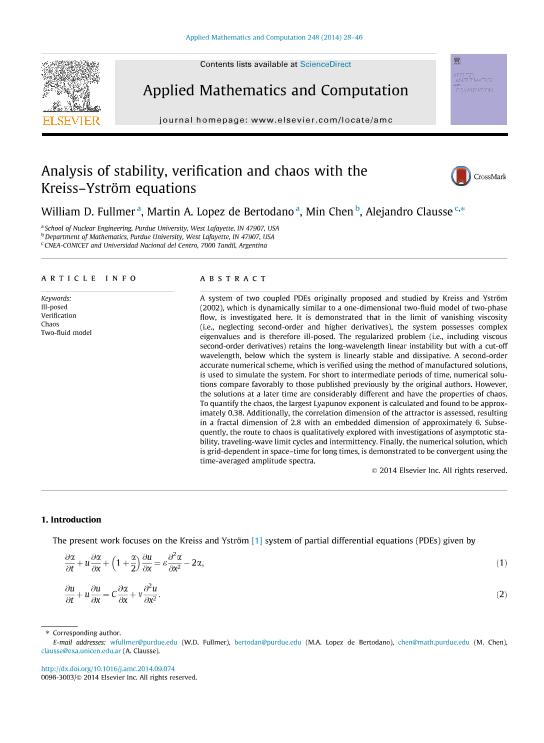Mostrar el registro sencillo del ítem
dc.contributor.author
Fullmer, William D.
dc.contributor.author
López de Bertodano, Martin A.
dc.contributor.author
Chen, Min
dc.contributor.author
Clausse, Alejandro

dc.date.available
2018-01-15T18:39:07Z
dc.date.issued
2014-10
dc.identifier.citation
Chen, Min; Clausse, Alejandro; López de Bertodano, Martin A.; Fullmer, William D.; Analysis of stability, verification and chaos with the Kreiss-Yström equations; Elsevier Inc; Applied Mathematics and Computation; 248; 10-2014; 28-46
dc.identifier.issn
0096-3003
dc.identifier.uri
http://hdl.handle.net/11336/33278
dc.description.abstract
A system of two coupled PDEs originally proposed and studied by Kreiss and Yström (2002), which is dynamically similar to a one-dimensional two-fluid model of two-phase flow, is investigated here. It is demonstrated that in the limit of vanishing viscosity (i.e., neglecting second-order and higher derivatives), the system possesses complex eigenvalues and is therefore ill-posed. The regularized problem (i.e., including viscous second-order derivatives) retains the long-wavelength linear instability but with a cut-off wavelength, below which the system is linearly stable and dissipative. A second-order accurate numerical scheme, which is verified using the method of manufactured solutions, is used to simulate the system. For short to intermediate periods of time, numerical solutions compare favorably to those published previously by the original authors. However, the solutions at a later time are considerably different and have the properties of chaos. To quantify the chaos, the largest Lyapunov exponent is calculated and found to be approximately 0.38. Additionally, the correlation dimension of the attractor is assessed, resulting in a fractal dimension of 2.8 with an embedded dimension of approximately 6. Subsequently, the route to chaos is qualitatively explored with investigations of asymptotic stability, traveling-wave limit cycles and intermittency. Finally, the numerical solution, which is grid-dependent in space–time for long times, is demonstrated to be convergent using the time-averaged amplitude spectra.
dc.format
application/pdf
dc.language.iso
eng
dc.publisher
Elsevier Inc

dc.rights
info:eu-repo/semantics/openAccess
dc.rights.uri
https://creativecommons.org/licenses/by-nc-nd/2.5/ar/
dc.subject
Two-Fluid Model
dc.subject
Ill Poseness
dc.subject
Chaos
dc.subject.classification
Ingeniería Mecánica

dc.subject.classification
Ingeniería Mecánica

dc.subject.classification
INGENIERÍAS Y TECNOLOGÍAS

dc.title
Analysis of stability, verification and chaos with the Kreiss-Yström equations
dc.type
info:eu-repo/semantics/article
dc.type
info:ar-repo/semantics/artículo
dc.type
info:eu-repo/semantics/publishedVersion
dc.date.updated
2016-11-23T19:55:06Z
dc.journal.volume
248
dc.journal.pagination
28-46
dc.journal.pais
Estados Unidos

dc.description.fil
Fil: Fullmer, William D.. Purdue University; Estados Unidos
dc.description.fil
Fil: López de Bertodano, Martin A.. Purdue University; Estados Unidos
dc.description.fil
Fil: Chen, Min. Purdue University; Estados Unidos
dc.description.fil
Fil: Clausse, Alejandro. Comisión Nacional de Energía Atómica; Argentina. Consejo Nacional de Investigaciones Científicas y Técnicas; Argentina
dc.journal.title
Applied Mathematics and Computation

dc.relation.alternativeid
info:eu-repo/semantics/altIdentifier/doi/http://dx.doi.org/10.1016/j.amc.2014.09.074
dc.relation.alternativeid
info:eu-repo/semantics/altIdentifier/url/http://www.sciencedirect.com/science/article/pii/S0096300314012995
Archivos asociados
